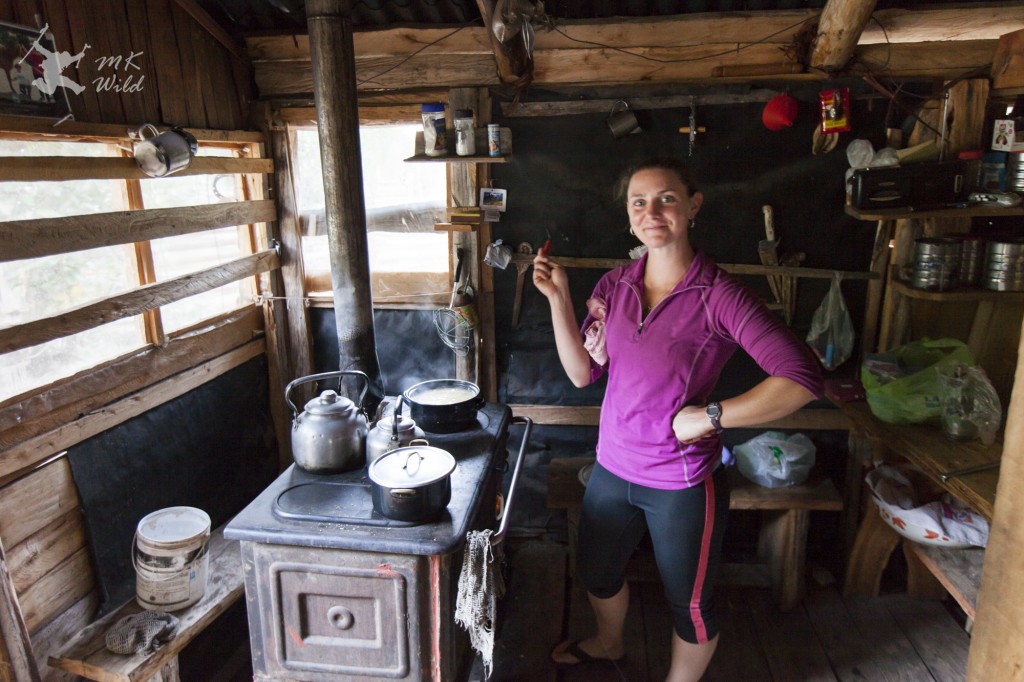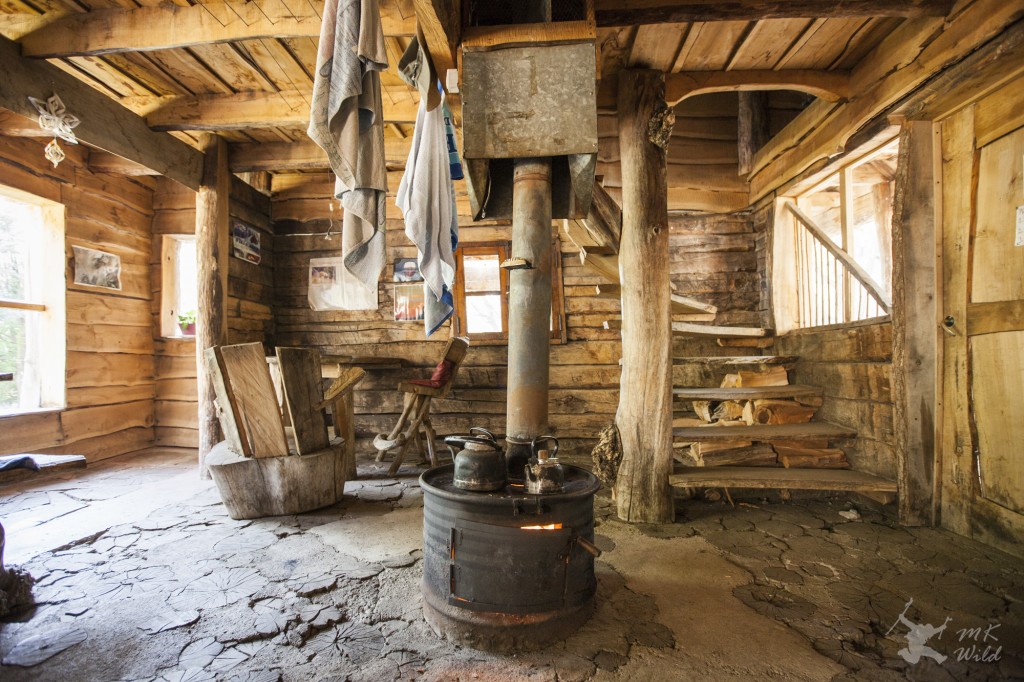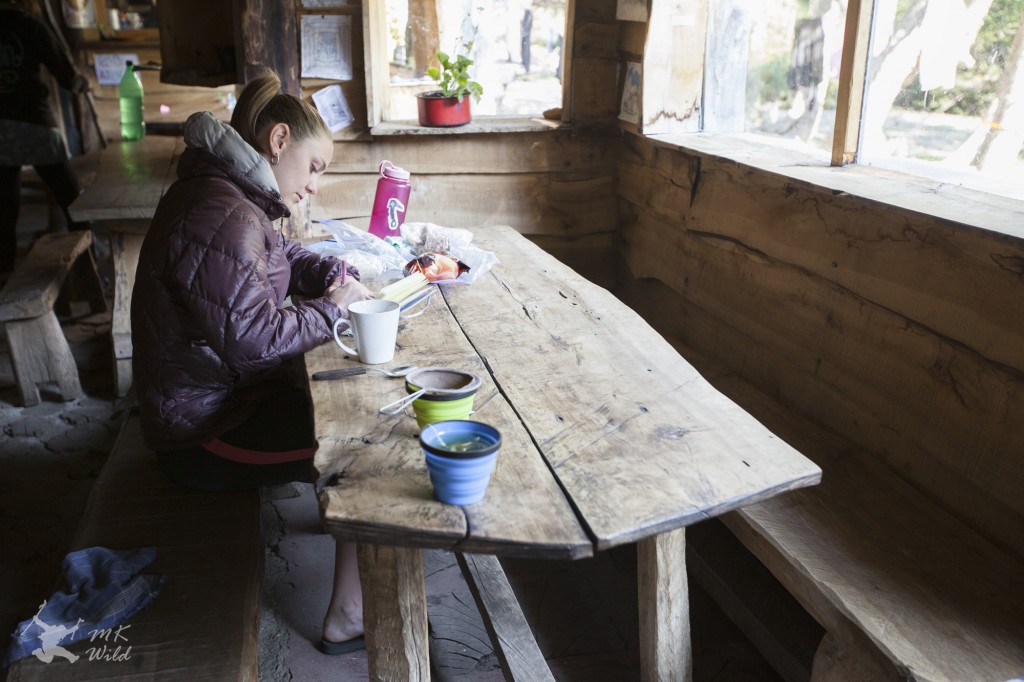
It’s past 8 o’clock at night and the warm summer sun is just starting its lazy descent behind the serene mountains. Seemingly tangible rays of light are reflected on the surface of the crystal clear water of Rio Azul, flowing down from the mountains and sustaining the city of El Bolson far below. Fish dance on the river’s surface.
We are at Refugio Tronconada, a small organic farm that hosts the infrequent backpacker deep in the friendly mountains of Northern Patagonia, Argentina. Michael is swinging gently in a hammock, reading a book and sipping on a homemade beer. A volunteer staffer is taking out the leftover scraps of food from the kitchen to feed the chickens that cluck cluck cluck around her feet as she walks the grounds. A young gaucho, the owner, is rounding up a flock of sheep with his gentle, sweet and shaggy dog at his side, bringing them into the hand-built corral a safe distance from the garden. His wife is also hard at work, doing a series of small but necessary jobs with her naked toddler in tow.

Each refugio outside of El Bolson offers an assortment of goodies made from scratch, including delicious house beer

The owner of Refugio Tronanada takes a moment to read in his wooden chair inside the dirt-floor kitchen/common area

Refugio trekking offers all the comforts of home, including healthy pets and bucket showers
With one hand I stroke the fire in the wood burning stove, learning by trial and error how to cook a full meal with only a pot, a wooden spoon and wood for fuel. With the other hand I hold a tiny white kitten with shockingly blue eyes, so small he fits in my palm, while his slightly bigger companion playfully swerves and meows around my legs on the dirt floor.

Taylor tries not to laugh at her own evolving attempts to cook with a wood-burning stove

The warm and cozy inside of Refugio Hielo Azul

Taylor journaling with coffee inside the refugio, one of the many reasons we rarely started moving before 11am each day
Clothing seems like an inconvenient and unnecessary social convention; fuel and electricity threaten to disrupt the natural cycle of the day; the water is so pure and clean that we drink directly from the stream without question. Somehow we stumbled into an authentic hippie life and we don’t know how we will ever pull ourselves away.

Walking along the Rio Azul

Enjoying another night at a campfire as the last traces of sunset color the sky
However, our transition to here from Asia wasn’t exactly smooth or happy. We arrived in Buenos Aires, Argentina, chronically exhausted from two jam-packed weeks that included temporary stays in 4 vastly different time zones, 7 long-distance busses and flights (5 of them overnight), and a marathon of other logistics. We did not find Buenos Aires particularly charming or safe, and we were eager to get to the fairy tale land of Patagonia. We booked a bus to Bariloche, the heart of the Lakes District in Northern Patagonia.

One of many overnight bus rides, done in style with sleeping bags, coffee, and front row seats, as we journey through this gigantic country
Without a doubt, Bariloche is one of the most beautiful cities we have ever seen. Situated on the largest of many sparkling blue lakes and framed by the Andes mountain chain, this Swiss-styled city thrives on artisan chocolates, locally brewed beer, cheap red wine and meat – lots and lots and lots of meat. Meat piled on top of meat. We arrived just in time for the heart of summer. The temperature ranged from 65-90 F and rarely was there a cloud in the blue bird sky. Even in our chronically sleep-deprived state with precisely zero energy reserves, we knew that we would enjoy our time here.

One of the many gorgeous view of Laguna Nahuel Huapi from Bariloche, a swiss-themed town known for its mind-blowing chocolate and artisan beer
Unfortunately, we arrived the day before Carnaval, the biggest holiday of the year, and almost all affordable hostels were totally booked. Feeling like old geezers who didn’t want our sleep to be disrupted by those loud, drunken young people partying in the street, we made our way out to Colonia Suiza, a single dirt-road village of craftspeople with what must be the highest brewery per capital in the world (4 breweries and a year-round population of less than 100 people). We filled the next few days with hiking, sport-climbing, shopping, beer sampling, and sunbathing by the lakes – and sleeping. Lots and lots of sleeping.

We enjoyed the height of Argentina’s summer in Colonia Suiza next to Lago Perito Moreno

After the inevitable lazy morning, we searched for sport climbing crags from our hosteria outside of Bariloche. Unfortunately, we forgot Taylor’s harness, so we made a makeshift one from webbing that we are totally pretty sure was 100% safe-ish.
Having heard other travelers describe the even more laid-back vibe of El Bolson, a town two hours south where something like 80% of all hops in Argentina are grown, we decided to head there for a day or two of casual hiking. While it was luxury to bask in the town’s paradise-like climate and surroundings, we discovered that the true gem of El Bolson is the network of family-operated refugios that dot the nearby mountains, each with a personality as distinct as its owners and all offering authentic homestay-like shelter to passing backpackers. After completing a 3-day refugio circuit, we were so in love with the area and the experience that we restocked on food and went back out for another six days. We hopped from refugio to refugio, each day simplified to nothing more than a relaxing morning, two-to-four hours of backpacking, sunbathing and swimming in the afternoon, and then finally cards, a delicious dinner, and homemade beer in the evening. Life was nothing short of glorious.

Taylor moves through the various outbuildings behind Refugio Los Laguitos

An outside view of Refugio Retamal, one of the many beautiful hand-crafted buildings along the trekking trails outside of El Bolson
Sometimes the best experiences are those you never expected, the places you didn’t know existed and didn’t plan to visit, but serendipitously fall into your lap and deliver just what you wanted or needed. After the most difficult and trying period of our trip – transitioning from Thailand – when all the inconveniences and stresses of long-term travel were piling on top of each other, taxing our emotional endurance and making us wonder whether it’s all worth it, El Bolson appeared and gave us the opportunity, space, and relative comfort to return to an excited and appreciative mindset.

We spent our afternoons reading and playing card games in the sunshine

The forests we trekked through were some of the most beautiful, thriving terrain we experienced our the entire trip

Michael scrambles up New Year Peak to get a better view of a remote valley near Refugio Los Laguitos

The refugios truly offered us “refuge” from the seemingly endless jet lag and logistical fatigue after leaving Asia
Almost two weeks after we arrived in El Bolson, we started to feel a shift in the air and see some changes in the leaves – the early signs that fall was coming. Amazingly, we had still not made it to The Frey – a famous rock-climbing destination hovering over Bariloche – which was the sole reason we came to Bariloche in the first place.

A view of the cirque of rock towers known as The Frey from Laguna Toncheck
With time running out, we loaded up our packs with food and climbing gear, ready to take advantage of the remaining weather window. But Life had other plans for us. A nighttime sniffle turned into a sore throat for Michael, then quickly transformed into a fever, severe chills, and an invisible tether to the nearest porcelain throne. We watched a perfect climbing day slowly pass us by from the open window of our hostel.
Sometime in the early afternoon, as I was re-organizing gear and attempting to generally contain the explosion of stuff that happens every time we open our backpacks, I noticed ashes collecting next to Michael on the bed. I had smelled smoke, but assumed it was from one of the huge asados (barbeques) for which this area is known. I went downstairs to find the hostel manager speaking furiously into the phone, stress and anxiety shining in her large brown eyes. There was a fire. It was coming this way. It was very close to us. We may need to evacuate.
Michael decided to investigate and went out the back door of the hostel; immediately, he came back wild-eyed and yelling, grabbing our most valuable possessions. Just a few meters away, massive orange flames rose from crackling trees and smoking houses. It quickly became an all-hands-on-deck situation. We evacuated our possessions onto the street, along with some items from the hostel, which I guarded while Michael helped a staff member throw buckets of water all over the back patio and trees to strengthen its natural resistance and create a protective barrier. Police and firemen worked together with hundreds of residents and travelers using hoses and bucket lines to combat the flames. Amidst the fear and danger was an incredible sense of strength, resilience and community. The fire was eventually contained and then fully extinguished by nightfall, leaving 10 houses damaged, 3 of which were fully destroyed, and 6 people injured in its wake. According to later news reports, the fire was attributed to arson.

Scenes from the frightening fire that consumed and damaged 10 houses right next to our hostel in Bariloche
After several more hours of risk assessment and just as the sun went down, the authorities deemed our hostel the very closest building to the burn area safe to re-enter. With an almost giddy sense of relief, the staff and few remaining travelers congregated in the living area and shared empanadas and wine while watching coverage of the fire play and replay on the evening news. Finally settled from the energy of the day, and with poor, sick Michael barely able to stand, we retired to our room feeling extremely lucky that it was unharmed.
The next day, with Michael somewhat recovered but generally unwilling to watch another good weather day go by, we re-packed everything once again and hiked our way up the valley behind Bariloche to Refugio Frey, and small and rustic building situated at the end of a lake surrounded by a huge cirque of rock towers lining the ridge like a misshapen crown. These towers and their rock faces offer some of South America’s best and most accessible traditional climbing routes. People of all ages and nationalities come here to hike and climb, relax by the lake, and swap travel stories around the refugio.

The trail hiking into The Frey had an outstanding view of a nice rainbow along the shores of Lago Gutierrez, yet another big and beautiful lake next to Bariloche

Taylor climbs a small tower to get a better look at the sentinals surrounding her, with Torre Principal standing the tallest directly in the center of this view
The next few days were all deserving of our highest praise: each was “a great day in the mountains.” We climbed, played on various rock features, took lots of photos, and then watched the sun set over the lake from the vantage of our campsite. Unfortunately, the day often then devolved into combat cooking in the tiny refugio kitchen (2 gas burners for a pack of hungry climbers is simply not sufficient), but this task was made bearable by plentiful wine.

Michael plays around on the top of one of the Tres Marias as we take advantage of a blue bird day in The Frey

Refugio Frey offers shelter from the oncoming dark skies, heavy with rain and moving quickly towards our camp

Our tent at The Frey, shielded from the wind by its rock fortress, which still doesn’t weaken the wind enough to prevent our tent from being lifted up in a storm
On our final day, we set our sights on a route up Torre Principal, the highest peak of the range that’s visible for miles outside of Bariloche. The sky was blue, the day was warm, and, while the climbing was a little stiffer than we expected, it was still well within our ability. As we rose higher on the face, clouds started accumulating above us, moving with shocking speed through the sky but followed by still more and more clouds. We came upon an incredibly unusual feature high on the tower: a bus-sized block of solid rock had cleanly broken and shifted away from the bedrock leaving a 3-6 foot V-shaped space that we had to climb through. While dramatic by itself, this feature also created a dynamic funnel that exposed us to our first taste of Patagonian winds.

The view of the valleys below from a convenient ledge on our climb up Torre Principal
This wind is strong. Powerful. So fast it seems to vibrate you from the inside out. It creates a hum, an almost singsong sound that starts with a buzz and crescendos to a loud whistle until the gust dies down, leaving an auditory void. Instinctively, it’s terrifying. Or thrilling, depending on your nature. Michael climbed through the vortex, hooting and hollering about how cool it was, although most of his words were simply carried away into the ether. I clenched my teeth and focused on my breathing, make-believing that, if I tried hard enough, I could enjoy this. While that didn’t work, I did get through to the next section, which wound its way back to the protected side of the mountain. A short traverse later got us to the base of the summit block, where we found two other teams in line for the last pitch. Go figure that out of all the routes on all of these mountains, 3 separate teams would converge on the same pitch at almost exactly the same time. Despite the acceptably warm temperature, the wind was quickly chilling me to the bone so we decided to forego the finale and get started on what promised to be a descent inevitably complicated by wind-twisted knots and tangles in our rope (which it indeed was).
Once safely down, we hiked back to camp to watch as the wind gusts beat down tents, snapped tent poles (thankfully not ours), and carried away debris. All night long it torpedoed through the slits in the rock wall meant to protect our tent and, despite this barrier, still lifted up all sides of our tent while we were in it, threatening to carry us away. It wasn’t the best night of sleep we’ve had.

The swirling clouds pick up a spectrum of sunset’s colors, pierced by the rock spires of The Frey
It continued the next morning and we did our best to pack without letting any single item stray unattended for fear of it being carried away by a gust. Ten minutes down the trail and into the valley, we were in a different world. No wind, tall trees, even blooming flowers. No doubt now – we are in Patagonia.
After hot showers, a final happy hour at our favorite pub, and a good night’s sleep, we boarded what promised to be our longest bus ride ever – around 30 hours – this time to El Calafate, the launching point for Southern Patagonia’s most popular destinations.


